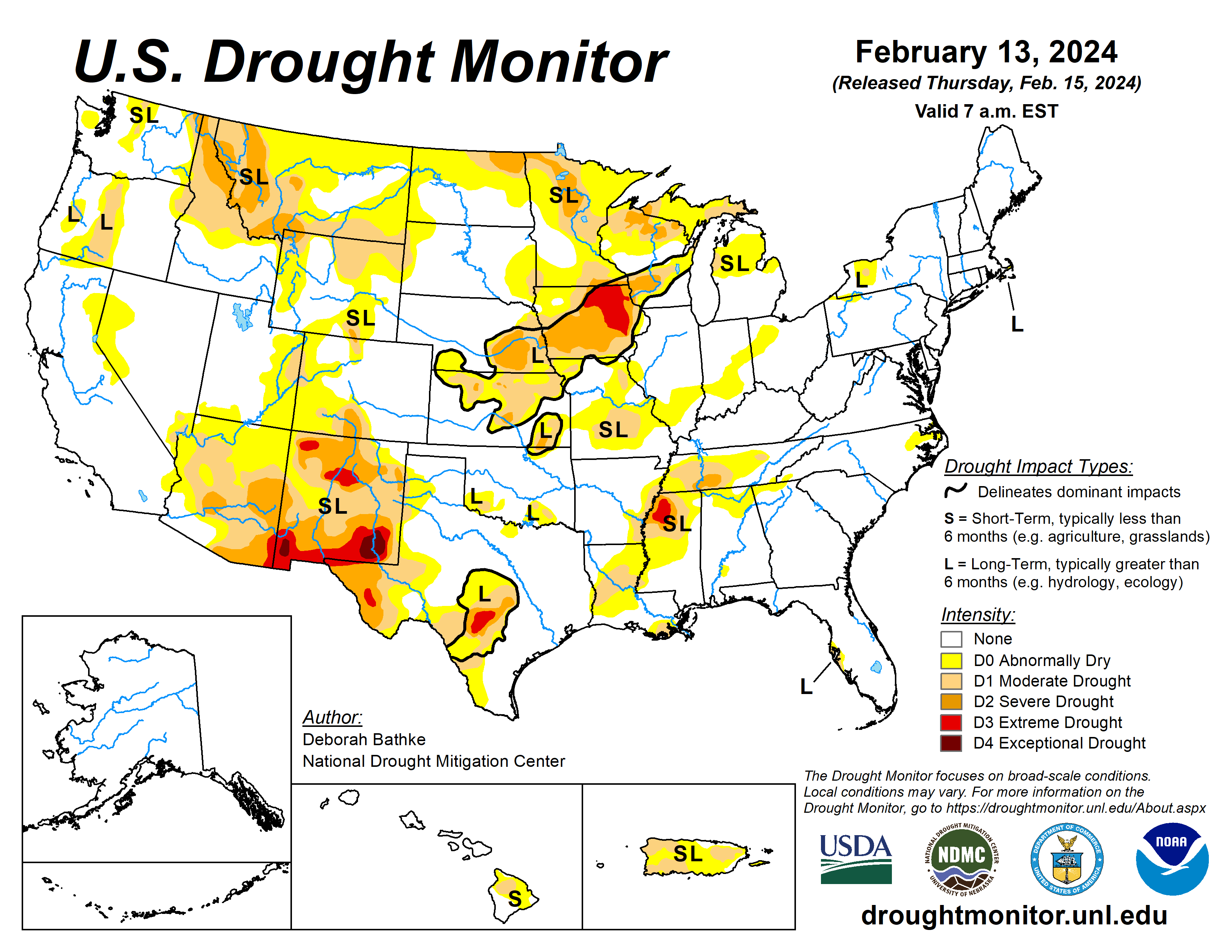Pacific storms dump snow into Colorado, New Mexico

Another round of Pacific storms swept across the West, bringing rain and mountain snow in the past week.
Storms left over 3 feet of snow in the northern Arizona mountains before dropping more than a foot of snow in the mountains of Colorado and New Mexico. After a slow start to the year, basin snowpack in the Southwest has returned to near-normal conditions. Southwestern states saw improvements to short- and long-term drought conditions.
In the Northwest, basin snowpack remains below normal with some of the worst conditions in the northern Rocky Mountains. The lack of snow led to the expansion of drought conditions. The wet pattern continued in the South and Southeast. In the last 30 days, rainfall totals of more than 10 inches (200 to 400% of normal) fell in parts of the South and Southeast.
The excess rain brought additional one- and two-category improvements to drought. The northern Plains and Upper Midwest stayed relatively dry, with temperatures well above normal for the second week in a row. States in the southern Plains saw pockets of improvements as long-term moisture deficits are finally showing signs of improvement.
The U.S. Drought Monitor is jointly produced by the National Drought Mitigation Center at the University of Nebraska-Lincoln, the U.S. Department of Agriculture and the National Oceanic Atmospheric Administration. (Map courtesy of NDMC.)
South
Another round of wet weather brought 2 to 4 inches of rain to parts of Louisiana, Mississippi, and Tennessee. The continued wet weather left a band, stretching from east Texas to northeast Alabama, with rainfall totals of 6 to 12 inches—200 to 400% of normal—over the last 30 days.
Much of the region saw 1- and even 2-category improvements to drought conditions. All exceptional drought (D4) has been eliminated. Moderate (D1), severe (D2), and extreme (D3) drought remain in the region where drought signals can still be found in long-term indicators.
Despite the record-breaking rainfall over the last several weeks, deficits of 4 to 10 inches over the last six months remain over parts of many parts of the region. Groundwater levels and deeper soil moisture also remain historically low for this time of year in some places.
West Texas was the only area where drought expanded. Moderate drought (D1) was added in response to growing long-term moisture deficits and impacts to soil moisture, groundwater and vegetation.
Midwest
High temperatures averaged from 7 to 20 degrees Fahrenheit above normal. Precipitation was less than 1 inch across most areas. Changes to the map were limited areas of D0 (abnormal dryness).
D0 expanded in Wisconsin and near St. Louis in response to the recent warm dry weather and lowered streamflow values. D0 was removed southeast Missouri, where rainfall totals have been above normal.
High Plains
High temperatures averaged about 8 to more than 20 degrees above normal. Precipitation of less than 0. 5 inches fell across much of the Dakotas, Nebraska, and Kansas. Southwest Nebraska, Kansas, and eastern Colorado saw 1-category improvements to long-term drought areas.
Short-term moisture deficits have largely been eliminated. A dry signal remains in Nebraska and Kansas at timescales longer than about six months and moisture deficits linger in deeper soil levels and ground water.
Moderate drought (D1) expanded in western South Dakota, near the Black Hills, and northeast Wyoming due to a lack of snow and below-normal soil moisture levels.
West
Basin snowpack in the Southwest has returned to near-normal conditions, prompting improvements to areas of moderate (D1), severe (D2), extreme (D3), and exceptional (D4) drought. The largest improvements occurred in New Mexico and southwest Colorado. In the Northwest, basin snowpack remains below normal with some of the worst conditions in the northern Rocky Mountains.
This lack of snow led to the expansion of D1 across southern Montana, northern Wyoming, central Idaho, and south-central Oregon. D2 expanded in eastern Idaho and western Montana. D1 improved in southern Washington and northern Oregon where above-normal precipitation over the last six months has helped reduce long-term moisture deficits.
Looking ahead
The National Weather Service’s Weather Prediction Center forecast for Feb. 15 to 17 calls for another round of rainfall to push into the West Coast, bringing heavy rain and high elevation snow to the Cascades, Sierra Nevada, and the Northern Rockies. Polar air from Canada is expected to bring cold, dry air into the northern Plains.
Snow is expected across the central Plains and Ohio Valley. Heading into the weekend, the extended forecast for Feb. 17 to 21 calls for increased chances of multiple atmospheric river events for parts of central and southern California. Areas of lighter precipitation may spread across other parts of the west.
Sign up for HPJ Insights
Our weekly newsletter delivers the latest news straight to your inbox including breaking news, our exclusive columns and much more.
The Upper Midwest and Northeast may see some snowfall. Storms tracking across the Gulf of Mexico may bring rain to Florida.
The Climate Prediction Center’s 6-to-10-day outlook for Feb. 20 to 24 calls for an increased probability of above-normal temperatures across most of the continental U.S. and Alaska. Temperatures across southern California, the East Coast, and northern Alaska are expected to be near to below normal.
Increased precipitation is expected across California, the interior West, southern Alaska, and the Northeast. Much of the remaining CONUS, northern Alaska, and the Big Island of Hawaii are expected to have below- or near-normal precipitation.
Deborah Bathke is with National Drought Mitigation Center.



